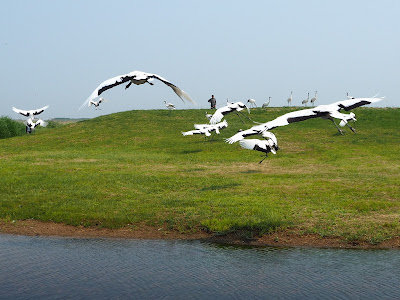The following morning after our arrival to Qiqihar from Harbin, we visited Zhalong Nature Reserve in Heilongjiang. The huge 2,100 sq. km freshwater marshland is the major migratory route for birds migrating from the Arctic to Southeast Asia. Within the reserve, a large flock of red-crowned cranes is held in captivity for conservation purpose.
Like all the visitors, we came to see the massive reed marshland and the red-crowned cranes. Twice a day, tourists come to see the feeding of the cranes by the park rangers. We came for the 11.00am session which is said to be better because the birds are more energetic. It was quite a "show" to see the cranes being led out from captivity and ushered to fly over the spectators before these birds settled by the pond for their feed.
Nothing goes to waste in China. Every year, reeds in the marshland are demarcated into zones and opened to contractors for bidding. Successful bidders would then harvest the reeds and sell them to paper mills. This is most suitable for the making of Chinese painting paper.
Red-crowned crane is highly regarded in China. It is also called Japanese Crane and Fairly Crane. These birds have an average life span of 30-40 years with some living to 70 years in captivity. To the Chinese, it is a symbol of luck, fidelity, longevity and immortality. China has considered naming it as their national bird but decided otherwise because of its Latin translation as "Japanese Crane". Any attempt by China to name it as their national bird will likely provoke strong resistance from Japan and Korea.
Red-crowned crane used as logo for Japan Airlines.














No comments:
Post a Comment